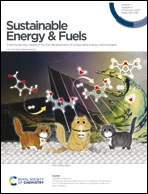Fabrication of a stable Au/Ta2O5 plasmonic photoanode for water splitting under visible light irradiation†
Abstract
Many investigations have been carried out on the production of hydrogen (H2) by water splitting using energy efficiently. We investigated photoelectrochemical water splitting (2H2O → 2H2 + O2) using the surface plasmon resonance of gold (Au) nanoparticles, in which tantalum pentoxide (Ta2O5) was selected as the supporting material for Au. Au/Ta2O5 powder was prepared by using the deposition precipitation (DP) method and subsequent calcination, and an Au/Ta2O5 electrode having a Ta2O5 layer of ca. 3 μm in thickness and Au0 nanoparticles of 6.4 nm in average size was fabricated by using a squeegee method. The prepared powder and electrode were characterized by scanning electron microscopy, transmission electron microscopy, X-ray photoelectron spectroscopy and X-ray absorption spectroscopy. The Au/Ta2O5/FTO electrode was used as the working electrode and the current–potential curve was measured under visible light irradiation, which showed photoresponse of more than 0.5 V vs. RHE. H2 and oxygen (O2) were continuously produced under visible light irradiation and with an externally applied potential of 0.8 V vs. RHE to a Pt counter electrode. The results of this study will provide a new strategy for photoelectrochemical water splitting using a plasmonic photoanode.



 Please wait while we load your content...
Please wait while we load your content...